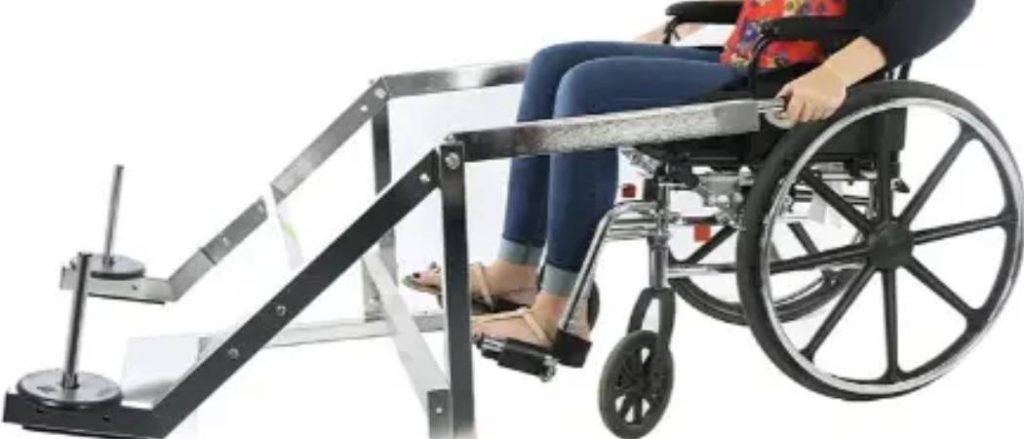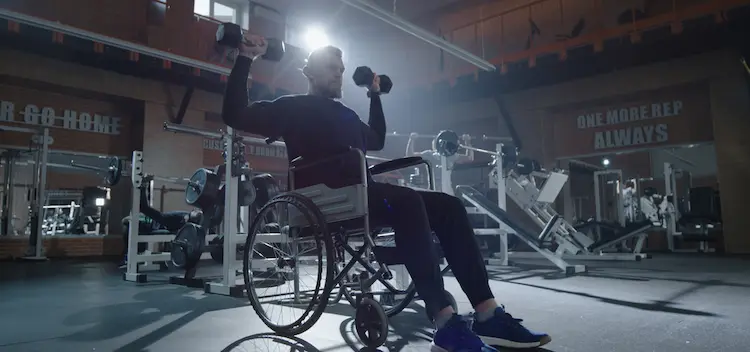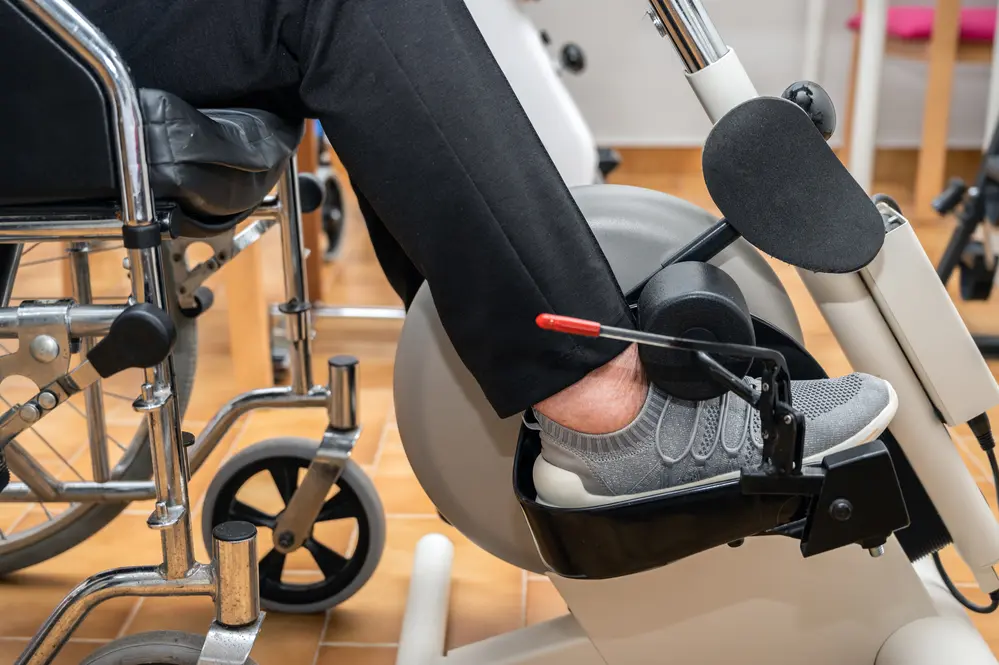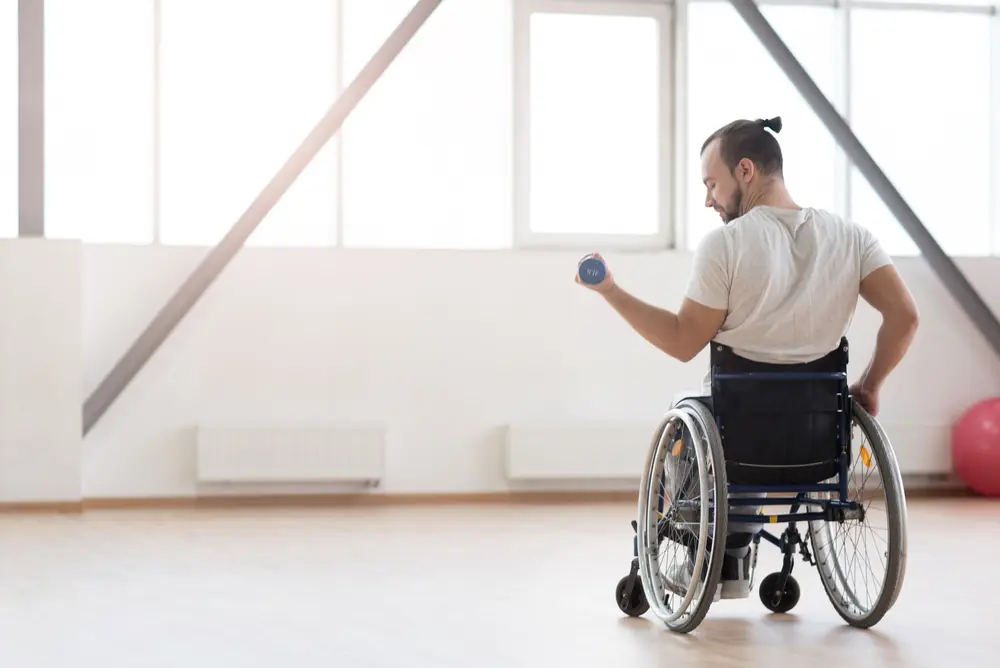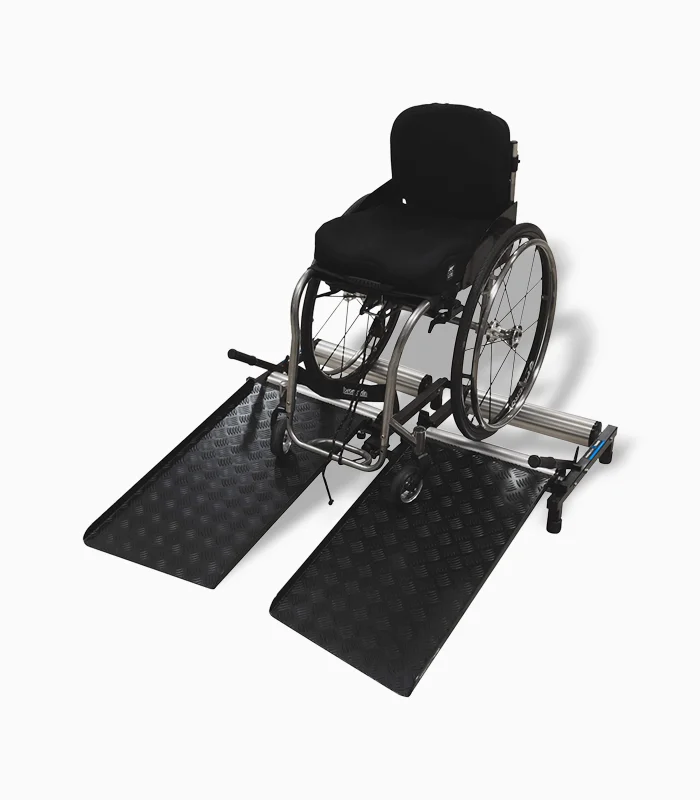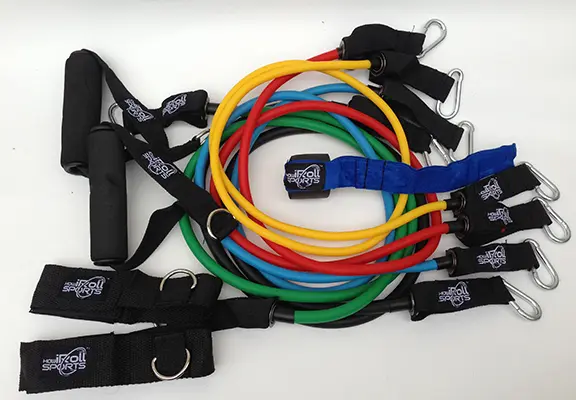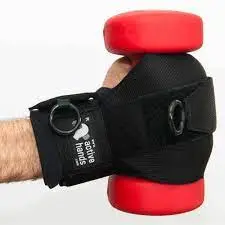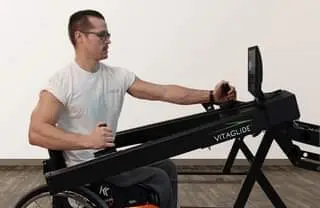If you or someone you know uses a wheelchair, you are likely aware of the significance of strength training and fitness for safe mobility. Almost 82% of disabled people preferred being physically active.
But maintaining fitness levels becomes challenging when limited mobility issues, muscular weakness, or handicaps are present.
Fortunately, you can get aid through wheelchair-accessible gym equipment. The article will explore the smart, specialized equipment that has taken over the disability exercise industry and the mainstream options available to enable disabled individuals to exercise regularly.
The Need for Adaptive Exercise Equipment For Wheelchair Users
Due to the limitations of their mobility equipment, conventional exercise machinery is typically inaccessible or inappropriate for wheelchair users. And many wheelchair users feel reluctant to use regular gyms.
That is why wheelchair exercise equipment works for various disabilities. It is a specialized machinery that facilitates fitness and regular exercise for wheelchair-using individuals like other non-disabled people.
Some other health benefits include,
- Lose weight
- Reduced risk of injury
- Improved bone density
- Reduced risk of heart and cardiovascular diseases
- Improved mental health and confidence
- Improve balance
- Muscle strength and flexibility
- Increase muscle strength
Even with a spinal cord injury or paralysis, equipment for wheelchair users can greatly aid in maintaining physical fitness and reducing their chances of obesity.
The Top Wheelchair Accessible Gym Equipment
Even though everyone is distinct and looking for a unique goal, there are a few staples in fitness equipment that everyone seems to agree on. Let’s dig into them.
Mini Exercise Bikes and Peddlers
A stationary bike or pedal exerciser can help a disabled person enhance their aerobic exercise, allowing them to boost their physical fitness, stamina, and strength.
The stationary device with hand or foot pedals was designed earlier for people who spend much time sitting and need to get their blood flowing. However, today, people with various conditions, including cardiac rehab, post-surgery rehab, and people with disabilities and mobility issues, use them.
Our Picks: Invacare Top End Handcycle Series, Sunny Health & Fitness SF-B0418 Magnetic Mini Exercise Bike, CanDo Chair Cycle, and Deluxe Resistive Pedal Exerciser are a few names that are best for lower and upper-body exercises.
Dumbells and Arm/Leg Weights
Dumbbells, especially those that are soft or made of materials like neoprene, can be a great addition to the workout routine of many disabled individuals and are an excellent method to strengthen your arms and hands for smooth wheelchair propulsion.
Start with smaller pairs and work to heavier weights as your health and strength improve.
Our Picks: We recommend Weider Neoprene Dumbbells and Core Home Fitness’s Adjustable Dumbbell Set.
Similar options to dumbbells are the arm and leg weights that attach to the legs and arms as a cuff and help to perform exercises for people with reduced gripping ability.
Adaptive Treadmills and Trainers
A common misconception is that treadmills are for able-bodied people only. But wheelchair users can improve their cardiovascular health and strength using rollers and treadmills. Rolling directly onto these adaptive treadmills requires no transfers; they’re cheap, compact, and easy to keep.
They also contain speed and elevation controls, handrails, and emergency stop buttons for the user’s protection.
The Invictus Active Trainer is a treadmill that allows users to alter their body weight to replicate a ‘road-like’ pushing experience. It is fully adjustable equipment that syncs with your mobile device to show you your pace, distance, and heart rate while working out.
A video showing the use of the Invictus Active Trainer by a wheelchair user
Other options include McClain Wheelchair Training Rollers and Sammons Preston Active Passive PRO. The latter is an elliptical trainer specially designed for senior and post-acute patients. It has various setting modes, from lower to higher functioning levels.
Resistance Bands
Resistance bands provide a good alternative for people who don’t like heavy weights but want to engage different muscle groups to build strength. They are great for overall, upper, middle, and lower body workouts.
You can strengthen your muscles by pulling or pushing against the bands after fastening one end to a fixed object like a door anchor and the other in your hand. Resistance is categorized based on color, with yellow being very light, red moderately light, green medium, blue medium to heavy, and black heavy, kept in a carrying case. It is always suggested to begin with the least weight and gradually increase it.
Our Picks: How iRoll Sports Adaptive Wheelchair Resistance Band Set, Wheelchair Workout Kit, and Perform Better Therabands are the best on the market.
A simple video showing how to perform the exercise with resistance bands for people in wheelchairs.
Medicine Balls
Another wheelchair-accessible piece of equipment is a medicine ball, which may target particular muscle groups to improve the top half of the body’s strength. It is also great for enhancing motor skills.
Here are a few medicine ball options that may work for those in wheelchairs, such as Dynamax Medicine Balls and THERABAND Soft Weights.
Wheelchair Grip Gloves
If you want to increase your level of activity but are worried about getting blisters on your hands, investing in a quality pair of wheelchair gloves is a wise move.
These gloves enable you to practice speed and precision while reducing the risk of hand injury.
Our Picks: Some recommendations include VitaGloves, Active Hands, and Grip Cuffs.
Refer to our article Seated Exercise for Obesity and Limited Mobility for complete details on performing a seated fitness routine with all the above equipment.
Specified Workout Machines
The following are wheelchair-specific exercise devices designed by a large and diverse selection of manufacturers and have much hype in the market.
Total Gym XLS
Anyone looking for a low-cost, space-saving, and effective full-body training machine for those with disabilities should consider the Total Gym XLS. The ultimate wheelchair fitness machine is used while lying down, reducing joint pressure, and works really well for people with a wide range of disabilities, from adults to geriatrics.
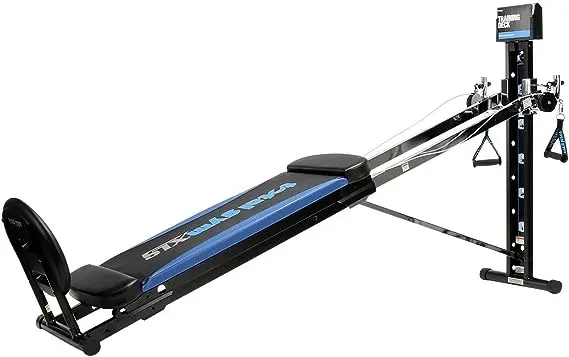
The Rickshaw Exerciser
The Rickshaw Exerciser is perfect for building the necessary strength for seated transfers. The Exerciser focuses on the upper-body muscles, particularly the deltoids and triceps in the shoulders, and the handles are fully adjustable and easily accommodate various body sizes.
Another similar suggestion is that the Selectorized Dip Rickshaw include its weight stack, eliminating the need to add, remove, or store weight plates to help you build strength.
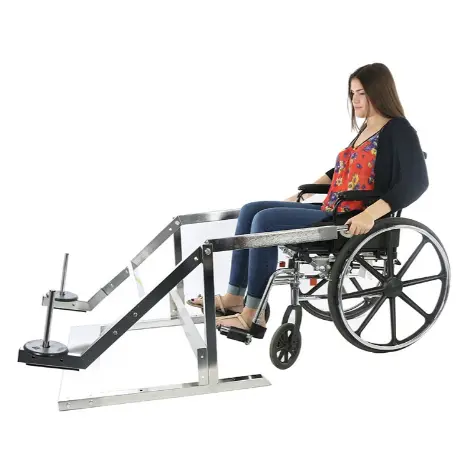
Wheelchair Fitness Solution™
Wheelchair Fitness Solution™ is the first all-inclusive workout setup developed for people who use wheelchairs. It offers 30 unique exercise regimens targeting different areas of the body.
The all-in-one machine features a central, stackable weight unit, extensions, and a patented harness for secure, high-quality gym workouts. Its quick-release clips allow smooth transitions between exercises, ensuring a comprehensive workout for individuals in wheelchairs.
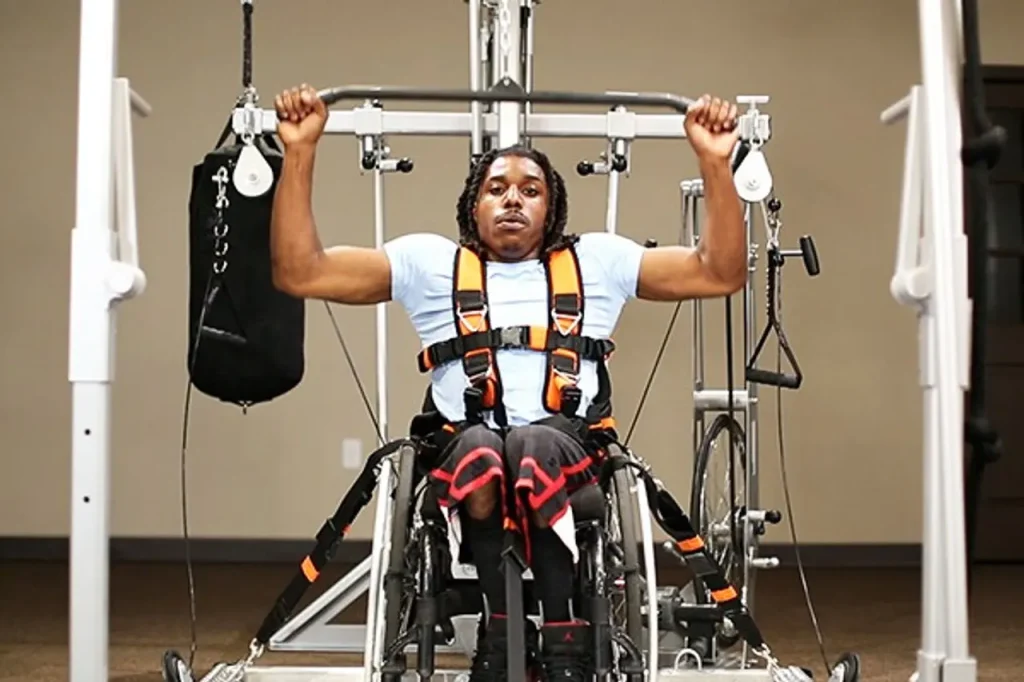
Vitaglide Wheelchair Fitness Machine
Propelling yourself in a wheelchair with your arms can be very exhausting. The VitaGlide’s revolutionary linear push-pull technology allows for a greater range of motion.
The Vitaglide Wheelchair Fitness Machine can save the shoulders and upper body from excess injury and improve cardiovascular fitness. It engages more muscle areas than conventional machinery and thus has its place as a wheelchair fitness solution.
A video showing how to use the Vitaglide machine for endurance and strength
The methods mentioned offer practical ways for wheelchair training and exercising at home, enhancing strength and endurance for wheelchair racing. To delve deeper into the world of racing wheelchairs, you can explore a comprehensive article dedicated to the subject.
The Frequency of Exercises For Wheelchair Users
No “magical” or “ideal” amount of exercise exists. Your training experience, goals, and frequency of practice will determine the figure.
The only thing that can be of great importance is the gradual increase in the exercise duration and then adding up the workout as you gain strength.
Also, whether you aim to increase your cardiac fitness, strength, or range of motion, you must be sure you’re using the correct equipment. Consult a qualified therapist and personal trainer for professional advice on accessible fitness equipment, who can adjust their recommendations based on user needs, constraints, and objectives.
Real-Life Examples
Rob, who uses a wheelchair because of a spinal cord injury, shows in the video how to correctly use free weights, weight machines, cable, and pulley machines.
Jesi Stracham, another wheelchair user, shows how she does her leg curling exercise on the available equipment in her gym.
All the above examples show that being disabled is not an adequate justification for avoiding physical activity and shouldn’t prevent you from working toward your well-being and fitness goals.
Conclusion
Wheelchair users may now participate in meaningful fitness routines owing to the wide variety of workout equipment explicitly made for home gyms. Examples include treadmills with handrails, equipment adjustments, and resistance bands with comfortable grips.
